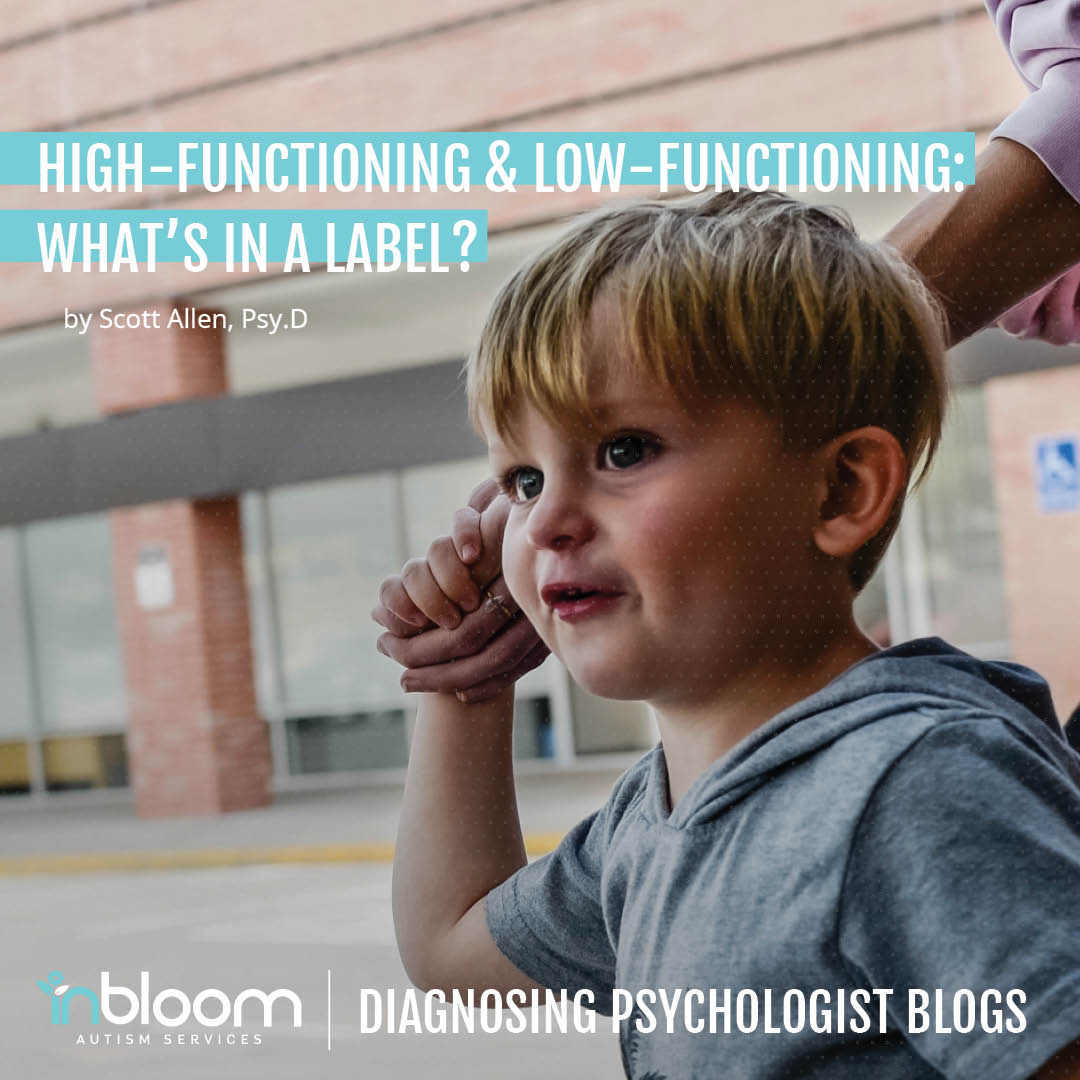High-Functioning & Low-Functioning: What’s in a Label?

Labels have a few benefits; they are ways to describe people efficiently and they allow us to communicate with people by sharing our conceptual knowledge. However, labels often can stick on people and even “positive” labels can be harmful over time.
“It is best to view individuals with autism spectrum disorder in terms of their skill profiles rather than their labels” – Dr. Scott Allen PsyD, a Licensed Psychologist at InBloom.
In this blog, Dr. Allen explains the truth behind commonly used autism labels such as ‘high-functioning’ or ‘low-functioning’ and how to better describe individuals on the autism spectrum.
The Truth About Labels When Diagnosing Children with Autism
Throughout my career, I have worked with individuals with autism as well as their parents and families. In my current diagnostic work, the question I hear the most from families after they receive a diagnosis of autism spectrum disorder is about the “functioning level” of their children. “Is she high functioning or low functioning?” This is not a new question, but it has been perpetuated by well-meaning educators/professionals, the media, and society as a whole. The question is a tough one to address because there are feelings tied to it.
Before I discuss my usual responses to these questions, I want to address the potential harms of this type of labeling:
1. Labels Can be Long-Lasting
When someone uses the labels “high-functioning” or “low-functioning,” they do not factor in that characteristics change over time. If these labels are used at initial diagnosis, they can impact caregivers’ views of children’s potentials or futures. Imagine how your life might have been impacted if everyone viewed one of your attributes at the age of 2 as permanent.
2. Labels Are Limiting
Labels often lead to misperceptions about capabilities and potential. When people picture individuals who are “high functioning” vs. “low functioning,” there are images that often readily come to mind. However, these images do not capture the full child, areas of strength, and areas of limitation. Even the term, “high functioning” is limiting as it paves the way for unfair assumptions to be made about the “high functioning” individual. Teachers and caregivers can assume that a “high functioning” individual is great at everything, and may miss areas of need due to broad labels. Internalized labels can ultimately impact an individual’s potential or willingness to learn. When facilitating social-skills groups with adults, I’ve been told, “I don’t need to learn that because I am ‘high functioning.”
3. Labels Can Be hurtful
Can you imagine what the world would be like if the labels “high functioning” and “low functioning” were used to describe everyone? My mind’s eye conjures images of one group who is viewed as superior in every way over the other just based on one label. Fortunately, we don’t generally talk about other people this way. We should not make an exception for people who are on the autism spectrum! There is nothing positive about the term “low functioning” and many adults with ASD have spoken out against this type of terminology. Low functioning is an unfair, demeaning way to view someone.
4. Labels are Self-Fulfilling Prophecies
There have been numerous studies on the effects of labeling over outcomes. In many of these studies, even when people are randomly assigned labels (e.g., intelligent, lazy, high-potential, etc.), others have interacted with them in a way that encourages them to fit the label. In other words, even if a label does not fully fit a child, others who interact with that child may actually behave toward that child in a way that fits the label. Over time, that child may meet expectations associated with the label. For example, if a teacher has two pupils with identical skill sets with one described as “slow” and the other as “high potential,” chances are that the teacher will unknowingly educate the children differently, leading to the eventual accuracy of the labels. The term, “Pygmalion Effect,” is used to describe situations when optimal outcomes are tied into optimal expectations.
No one is an expert at everything. Likewise, no one is horrible at everything. The labels, “high-functioning” and “low-functioning”, by nature, separate people into two groups. No one uses the term “medium-functioning.” The world is not that absolute and neither are people.
What’s the Alternative for These Labels?
Many professionals and self-advocates agree that it is best to view individuals in terms of their skill profiles rather than their labels. To illustrate this principle let me present two adults similar to adults I have worked with in the past.
Adult 1:
Labeled as “low functioning” with a “low IQ” as a child. Although these individuals did not go to college, they are quite successful in learning job skills. They have learned to take public transportation to get to work, work well with others, and earn a modest income to pay their bills. They also have sufficient earnings to buy a video game on occasion or go out to eat.
Adult 2:
Labeled as “high functioning” and “a genius” as a child. This individual attempted college but struggled with following a class schedule and completing assignments. They struggle with keeping their apartment clean and can not remember to pay their bills on time. They have a difficult time getting along with others at work, and although they want friends, they struggle with flexibility and interacting with others.
By most realistic accounts, it’s clear that while the labels might have at one point been backed up with data, they do not fully or accurately describe the individuals.
Individuals with ASD, like everyone else, have sets of strengths and challenges. No two humans with autism have the same profile, and it’s a disservice to them (or anyone else) to be categorized based on their “functioning levels.” Instead, it’s important to look at their specific skill sets to determine how to optimize their areas of strength and to support them as they work to overcome or live with their areas of challenge or barriers. In addition, their profiles can be used to determine the best methods for teaching them, ways that their environments can be modified, skill areas to target for intervention, and potential educational goals/career choices.
When I am asked about a kiddo’s functioning level, I consistently tell parents, educators, and professionals that I can’t sum up a child in one or two words. Instead, I focus on the entire child and use sentences like…
“We know he is good at _________.”
“She can work on ___________.”
“We can support them with ____________.”
“He is showing improvement with ___________.”
“Let’s focus on __________ SOON, so she can be successful in school.”
As in the last example, I often find that working on one or two areas of difficulty (e.g., flexibility and emotional control), can open doors to developing so many lifelong skills.
If I can encourage you to do anything as a result of this article, it is to take the words “high functioning” and “low functioning” out of your vocabulary. Instead, try to look at people with autism more broadly, as they, just like you, have areas of great strength and areas in which they can grow.
Written by: Dr. Scott Allen, PsyD
InBloom Autism Services specializes in early intervention ABA Therapy. Our Therapists undergo training to develop a curriculum specifically designed for children aged 5 and under with autism. Our Learning Centers also offer a safe and enjoyable environment for children to interact with their peers. Learn more about our ABA Therapy program!



